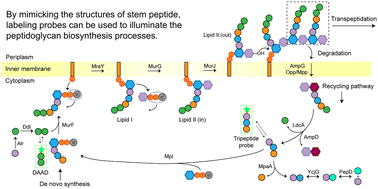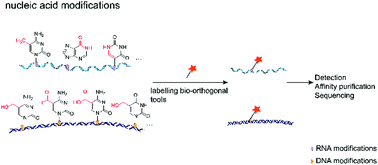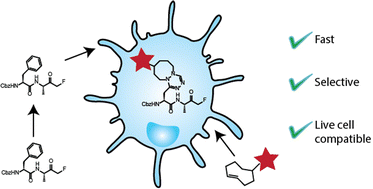Themed collection Development of bio-orthogonal tools

Introduction to ‘Development of bio-orthogonal tools’
Yan Zhang and Chengqi Yi introduce the RSC Chemical Biology themed collection on ‘Development of bio-orthogonal tools’.

RSC Chem. Biol., 2023,4, 109-109
https://doi.org/10.1039/D2CB90045A
Imitate to illuminate: labeling of bacterial peptidoglycan with fluorescent and bio-orthogonal stem peptide-mimicking probes
By imitating the structures of stem peptide, many fluorescent and bio-orthogonal labeling probes have been designed and used in illuminating the peptidoglycan biosynthesis processes.

RSC Chem. Biol., 2022,3, 1198-1208
https://doi.org/10.1039/D2CB00086E
Labeling and sequencing nucleic acid modifications using bio-orthogonal tools
Labeling nucleic acid modifications using bio-orthogonal tools, then sequencing and imaging the labeled modifications in DNA and RNA.

RSC Chem. Biol., 2022,3, 994-1007
https://doi.org/10.1039/D2CB00087C
Methyltetrazine as a small live-cell compatible bioorthogonal handle for imaging enzyme activities in situ
Bioorthogonal chemistry combines well with activity-based protein profiling, as it allows for the introduction of detection tags without significantly influencing the physiochemical and biological functions of the probe.

RSC Chem. Biol., 2022,3, 1325-1330
https://doi.org/10.1039/D2CB00120A
A library of Rhodamine6G-based pH-sensitive fluorescent probes with versatile in vivo and in vitro applications
Acidic pH is critical to the function of nearly every cell in the body. Based on Rhodamine 6G, we have developed a versatile molecular platform for non-invasive, real-time fluorescence imaging of acidic microenvironments based on Rhodamine 6G.

RSC Chem. Biol., 2022,3, 748-764
https://doi.org/10.1039/D2CB00030J
About this collection
Guest-edited by Chengqi Yi (Peking University, China) and Yan Zhang (Nanjing University, China), this collection highlights work on bio-orthogonal chemistry, reactions and probes in labeling, manipulating, imaging and sequencing of protein, DNA, RNA and bioactive metabolites.